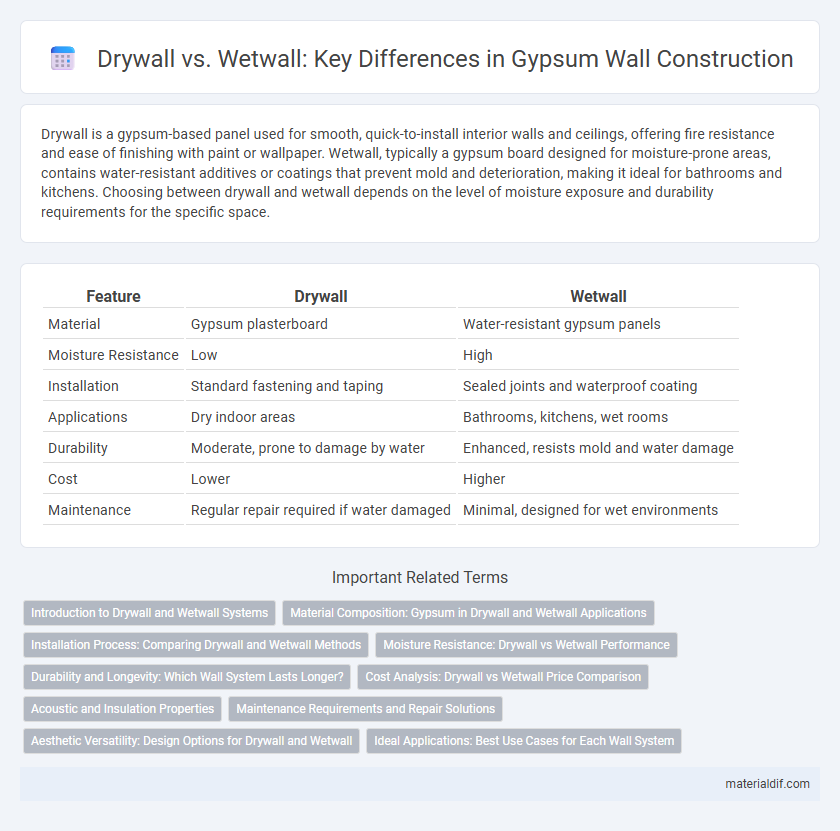Drywall is a gypsum-based panel used for smooth, quick-to-install interior walls and ceilings, offering fire resistance and ease of finishing with paint or wallpaper. Wetwall, typically a gypsum board designed for moisture-prone areas, contains water-resistant additives or coatings that prevent mold and deterioration, making it ideal for bathrooms and kitchens. Choosing between drywall and wetwall depends on the level of moisture exposure and durability requirements for the specific space.
Table of Comparison
| Feature | Drywall | Wetwall |
|---|---|---|
| Material | Gypsum plasterboard | Water-resistant gypsum panels |
| Moisture Resistance | Low | High |
| Installation | Standard fastening and taping | Sealed joints and waterproof coating |
| Applications | Dry indoor areas | Bathrooms, kitchens, wet rooms |
| Durability | Moderate, prone to damage by water | Enhanced, resists mold and water damage |
| Cost | Lower | Higher |
| Maintenance | Regular repair required if water damaged | Minimal, designed for wet environments |
Introduction to Drywall and Wetwall Systems
Drywall systems consist of gypsum panels that are fastened to wall studs, providing a smooth, fire-resistant surface widely used in interior construction. Wetwall systems integrate gypsum boards with moisture-resistant coatings or substrates, designed specifically for high-humidity environments like bathrooms and kitchens. Understanding the composition and application of drywall and wetwall systems is essential for selecting the right gypsum-based solution tailored to different building conditions.
Material Composition: Gypsum in Drywall and Wetwall Applications
Gypsum in drywall consists of a fine, dried powder pressed between heavy paper sheets, providing a rigid, fire-resistant panel ideal for interior walls and ceilings. In wetwall applications, gypsum is combined with water-resistant additives like fiberglass or polymers to create moisture-resistant boards suitable for high-humidity areas such as bathrooms and kitchens. The chemical composition includes calcium sulfate dihydrate, but wetwall gypsum products are engineered to maintain structural integrity and resist mold in damp environments.
Installation Process: Comparing Drywall and Wetwall Methods
Drywall installation involves securing gypsum panels to wall studs with screws or nails, followed by taping, mudding, and sanding to create a smooth surface. Wetwall installation uses a gypsum-based plaster applied directly onto a lath or mesh, which hardens to form a seamless, durable finish without the need for joint treatments. Drywall offers quicker installation with less drying time, while wetwall provides enhanced moisture resistance and a more uniform surface ideal for high-humidity areas.
Moisture Resistance: Drywall vs Wetwall Performance
Wetwall panels outperform drywall in moisture resistance due to their dense composition and water-repellent additives, making them ideal for bathrooms and kitchens. Drywall absorbs moisture easily, leading to mold growth and structural damage if exposed to high humidity without proper waterproofing. Choosing wetwall over drywall significantly enhances durability and longevity in moisture-prone environments.
Durability and Longevity: Which Wall System Lasts Longer?
Drywall, composed primarily of gypsum panels, offers moderate durability with resistance to fire and mold but can be susceptible to water damage and impact cracks. Wetwall, which incorporates gypsum plaster applied wet over a lath or substrate, provides superior strength and longevity due to its hard, seamless surface that resists dents and moisture better than standard drywall. In terms of lifespan, wetwall systems typically outlast drywall by maintaining structural integrity and appearance in high-traffic or humid environments.
Cost Analysis: Drywall vs Wetwall Price Comparison
Drywall installation typically costs between $1.50 and $3.50 per square foot, making it a more budget-friendly option compared to wetwall systems, which range from $4 to $7 per square foot due to additional waterproofing materials and labor. The higher price of wetwall reflects its superior moisture resistance and durability in wet environments like bathrooms and kitchens. Homeowners should weigh initial installation expenses against long-term maintenance savings when choosing between drywall and wetwall solutions.
Acoustic and Insulation Properties
Drywall made from gypsum board offers moderate acoustic insulation with its density and layered structure, effectively reducing airborne noise in residential and commercial spaces. Wetwall systems, incorporating gypsum with added moisture-resistant materials, enhance insulation performance by preventing moisture penetration while maintaining sound dampening qualities. Both drywall and wetwall provide essential thermal insulation benefits, but wetwall's moisture mitigation contributes to more durable acoustic and thermal protection in humid environments.
Maintenance Requirements and Repair Solutions
Drywall requires periodic patching and repainting to address common issues like cracks, dents, and water damage, with repairs often involving joint compound and sanding for a smooth finish. Wetwall, typically constructed from water-resistant materials like cement board or fiberglass, demands less frequent maintenance but may necessitate specialized sealants and mold remediation when exposed to moisture. Both systems benefit from regular inspections to prevent small defects from escalating into costly repairs, ensuring long-term durability in interior spaces.
Aesthetic Versatility: Design Options for Drywall and Wetwall
Drywall offers extensive aesthetic versatility with smooth surfaces that accommodate a wide range of paints, wallpapers, and textures, allowing for customizable interior designs and seamless finishes. Wetwall, composed of moisture-resistant gypsum boards, provides a durable base suitable for high-humidity areas, supporting tile installations and waterproof coatings that enhance both function and style. Both materials enable diverse design options, but drywall excels in intricate interior detailing while wetwall optimizes aesthetics in wet environments.
Ideal Applications: Best Use Cases for Each Wall System
Drywall is ideal for interior wall applications in residential and commercial buildings due to its cost-effectiveness, ease of installation, and smooth finish suitable for painting or wallpapering. Wetwall systems excel in moisture-prone areas such as bathrooms, kitchens, and basements, offering enhanced water resistance and durability with materials like cement board or fiberglass-reinforced panels. Choosing drywall for standard rooms and wetwall for high-humidity environments ensures optimal performance and longevity of wall systems in construction projects.
Drywall vs Wetwall Infographic

 materialdif.com
materialdif.com